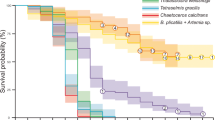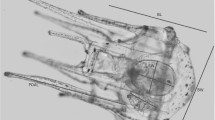Abstract
Methods are described for the successful rearing of northern anchovy larvae (Engraulis mordax Girard) on cultured foods. Larvae were fed successively on the unarmored dinoflagellate Gymnodinium splendens, the veliger of the gastropod Bulla gouldiana, and nauplii of the brine shrimp Artemia salina. Rearing containers ranging in capacity from 4.5 to 510 l were tested; the smaller ones were found to be most useful for laboratory experimentation. Irreversible starvation occurred when E. mordax were denied food for more than 1.5 days after yolk absorption. Growth rates of larval anchovies fed different diets were compared. Larvae fed G. splendens grew for 1 week at the same rate as animals fed wild plankton, but did not maintain this rate. Laboratory survival of E. mordax larvae on a diet of G. splendens alone, did not differ significantly when veligers supplemented the diet. However, when G. splendens and veligers were fed simultaneously to E. mordax larvae, growth rate was greatly improved, although still not matching the growth attained on a diet of wild plankton. Length (L) versus weight (W) analyses were made for all larvae at all diets. The results showed that weight could be calculated most accurately from length by the relationship log W=3.3237 log L-3.8205, regardless of diet.
Similar content being viewed by others
Literature cited
Anthony, R.: The cultivation of the turbot. Proc. 4th int. Fish. Congr., Washington, 1908. Bull. Bur. Fish., Wash. 28 (2), 859–870 (1910).
Arthur, D. K.: The particulate food and the food resources of the larvae of three pelagic fishes, especially the Pacific sardine, Sardinops caerulea (Girard). Ph.D. Thesis, 231 pp. University of California, Scripps Inst. Oceanogr. 1956.
Bardach, J. E.: The status and potential of aquaculture, particularly fish culture. Vol. 2, Pt 3 Fish culture, 225 pp. Springfield, Va.: Clearing House for Federal Scientific and Technical Information 1968. (Pages 22–29 of this work describe the rearing experiments of G. O. Schumann).
Berner, L.: The food of the larvae of the northern anchovy, Engraulis mordax. Bull. inter-Am. trop. Tuna Commn 4, 3–22 (1959).
Bhattacharyya, R. N.: The food and feeding habits of larval and post larval herring in the northern North Sea. Mar. Res. 1957 (3), 14 pp.
Blaxter, J. H. S.: Herring rearing — 4. Rearing beyond the yolk-sac stage. Mar. Res. 1962 (1), 18 pp.
—: The feeding of herring larvae and their ecology in relation to feeding. Rep. Calif. coop. oceanic Fish. Invest. 10, 79–88 (1965).
—: Rearing herring larvae to metamorphosis and beyond. J. mar. biol. Ass. U.K. 48, 17–28 (1968).
—: Experimental rearing of pilchard larvae, Sardina pilchardus. J. mar. biol. Ass. U.K. 49, 557–575 (1969).
—: Biologische Beobachtungen bei der Aufzucht von Heringsbrut. Helgoländer wiss. Meeresunters. 7, 260–284 (1961).
Bowers, A. B. and D. I. Williamson: Food of larval and early post-larval stages of autumn spawned herring in Manx waters. Rep. mar. biol. Stn Port Erin 63, 17–26 (1951).
Dannevig, A.: Rearing experiments at the Flødevigen seafish hatchery 1943–1946. J. Cons. perm. int. Explor. Mer. 15, 277–283 (1948).
Dannevig, H.: On the rearing of larval and post larval stages of plaice and other flatfishes. Rep. Fishery Bd Scotl. 1896 (3), 175–193 (1897).
Duka, L. A.: Food of anchovy larvae in the Black Sea. [In Russ.]. Trudy sevastopol'. biol. Sta. 14, 242–256 (1961).
—: Quantitative indices of the food of larval Black Sea anchovies. [In Russ.]. Trudy sevastopol'. biol. Sta. 15, 326–339 (1964).
Fabbe-Domergue et E. Biétrix: Développement de la sole (Solea vulgaris). Introduction à l'étude de la pisciculture marine. Travail du Laboratoire de Zoologie Maritime de Concarneau. 243 pp. Paris: Vuibert et Nony 1905.
Gabstang, W.: Preliminary experiments on the rearing of sea-fish larvae. J. mar. biol. Ass. U.K. 6, 70–93 (1900).
Kasahara, F., R. Hirano and Y. Oshima: A study on the growth and rearing methods of black porgy, Mylio macrocephalus (Basilewsky). [In Jap. English summary]. Bull. Jap. Soc. scient. Fish. 26, 239–244 (1960).
Kramer, D. and J. R. Zweifel: Growth of anchovy larvae (Engraulis mordax Girard) in the laboratory as influenced by temperature. Rep. Calif. coop. oceanic Fish. Invest. 14, (1970). (In press).
Lasker, R.: An experimental study of the effect of temperature on the incubation time, development, and growth of Pacific sardine embryos and larvae. Copeia 1964 (2), 399–405.
Lasker, R. and L. L. Vlymen: Experimental sea-water aquarium Bureau of Commercial Fisheries, Fishery-Oceanography Center, La Jolla, California. Circ. Fish Wildl. Serv., Wash. U.S. 334, 14 pp. (1969).
Lebour, M. V.: The food of post larval fish. J. mar. biol. Ass. U.K. 11, 433–479 (1918).
—: The food of post-larval fish No. 2 (1918). J. mar. biol. Ass. U.K. 12, 22–47 (1919).
—: The food of young fish No. 3 (1919). J. mar. biol. Ass. U.K. 12, 261–324 (1920).
—: The food of young clupeoids. J. mar. biol. Ass. U.K. 12, 458–467 (1921).
—: Rissoid larvae as food of the young herring. The eggs and larvae of the Plymouth Rissoidae. J. mar. biol. Ass. U.K. 19, 523–539 (1934).
Meyer, H. A.: Biologische Beobachtungen bei künstlicher Aufzucht des Herings der Westlichen Ostsee. Berlin: Wiegandt, Hempel & Parey 1878. Rep. U.S. Commnr Fish. 1878 (6), 629–638 (1880).
Morris, R. W.: Some aspects of the problem of rearing marine fishes. Bull. Inst. océanogr. Monaco 53 (1082), 61 pp. (1956).
Paine, R. T.: Food recognition and predation on opisthobranchs by Navanax inermis (Gastropoda: Opisthobranchia). Veliger 6, 1–9 (1963).
Rodhe, W.: Environmental requirements of fresh-water plankton algae. Symb. bot. upsal. 10, 1–149 (1948).
Rollefsen, G.: Artificial rearing of the fry of sea water fish. Preliminary communication. Rapp. P.-v. Réum. Cons. perm. int. Explor. Mer 109 (3), 133 (1939).
—: Utkekking ag appdretting ar saltvannfisk. Naturen 6/7, 197–217 (1940).
Shelbourne, J. E.: The artificial propagation of marine fish. Adv. mar. Biol. 2, 1–83 (1964).
Sweeney, B. M. and J. W. Hastings: Characteristics of the diurnal rhythm of luminescence in Gonyaulax polyedra. J. cell. comp. Physiol. 49, 115–128 (1957).
Author information
Authors and Affiliations
Additional information
Communicated by G. L. Voss, Miami
Rights and permissions
About this article
Cite this article
Lasker, R., Feder, H.M., Theilacker, G.H. et al. Feeding, growth, and survival of Engraulis mordax larvae reared in the laboratory. Marine Biology 5, 345–353 (1970). https://doi.org/10.1007/BF00346901
Accepted:
Issue Date:
DOI: https://doi.org/10.1007/BF00346901




